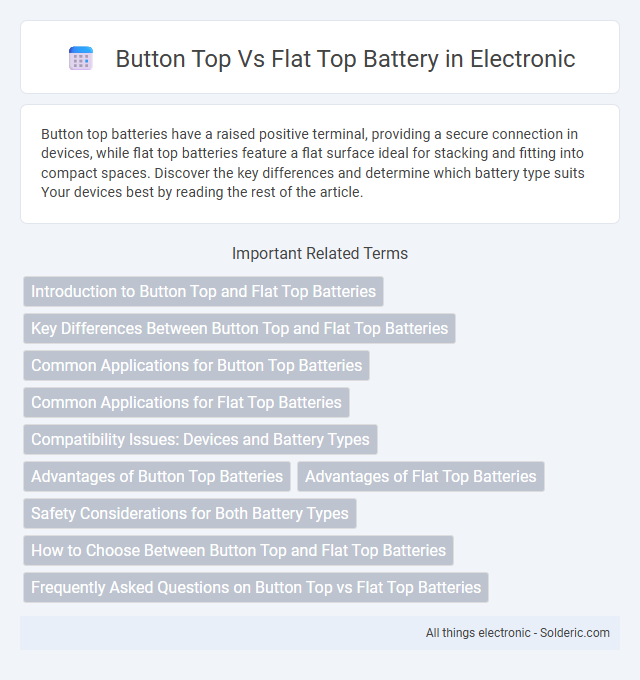Button top batteries have a raised positive terminal, providing a secure connection in devices, while flat top batteries feature a flat surface ideal for stacking and fitting into compact spaces. Discover the key differences and determine which battery type suits Your devices best by reading the rest of the article.
Comparison Table
| Feature | Button Top Battery | Flat Top Battery |
|---|---|---|
| Design | Raised positive terminal resembling a button. | Flat positive terminal with no protrusion. |
| Compatibility | Ideal for devices requiring protruding terminals like flashlights, cameras. | Better suited for devices with flat battery contacts like vape mods, battery packs. |
| Connection | Offers reliable contact in spring-loaded or flat contacts. | Requires flat-to-flat contact for secure connection. |
| Size | Slightly taller due to button top. | Uniform size, compact profile. |
| Usage | Common in AA, AAA rechargeable and alkaline batteries. | Popular in high-drain applications like vaping and power tools. |
| Safety | Reduced risk of short circuits due to raised terminal. | Requires careful handling to avoid short circuits. |
Introduction to Button Top and Flat Top Batteries
Button top batteries feature a protruding positive terminal that ensures secure contact in many devices, while flat top batteries have a level positive terminal designed for applications requiring flush installation. Your choice between button top and flat top batteries depends on the device's battery compartment design and the connection type it supports. Understanding these physical differences helps optimize battery performance and compatibility.
Key Differences Between Button Top and Flat Top Batteries
Button top batteries have a protruding positive terminal, making them ideal for devices requiring a snug fit with clear polarity, while flat top batteries feature a flush positive terminal for compact spaces or battery packs. The elevated button top can improve contact reliability in many consumer electronics, whereas flat top batteries often suit battery holders with springs or specialized connectors. Your choice impacts device compatibility, ensuring optimal power delivery and battery life performance.
Common Applications for Button Top Batteries
Button top batteries are commonly used in devices requiring a secure and consistent connection, such as flashlights, remote controls, and toys, due to their protruding positive terminal that ensures reliable contact. Their design is ideal for applications like cameras and handheld electronics where battery fit and stability are crucial. When selecting your battery, consider button top types for devices needing robust power delivery and easy battery replacement.
Common Applications for Flat Top Batteries
Flat top batteries are commonly used in devices like flashlights, power tools, and certain types of laptops due to their uniform height and stable stacking properties. Unlike button top batteries, flat tops fit more easily into battery packs that require tight spacing and easy contact without added protrusions. Your equipment may benefit from flat top batteries for consistent contact and compact design requirements.
Compatibility Issues: Devices and Battery Types
Button top batteries feature a raised positive terminal, making them compatible with devices requiring this design to ensure proper contact and prevent short circuits, whereas flat top batteries have a flush positive terminal suited for devices with spring-loaded contacts. Some high-drain devices or those with recessed battery compartments specifically require flat top batteries for secure fitting, leading to potential compatibility issues if the wrong battery type is used. Users must verify device manufacturer recommendations to avoid malfunctions and ensure optimal performance when selecting between button top and flat top batteries.
Advantages of Button Top Batteries
Button top batteries offer enhanced contact stability due to their raised positive terminal, reducing the risk of poor connections in devices. They are particularly advantageous for high-drain electronics like flashlights and vaporizers, ensuring consistent power delivery. Choosing button top batteries can improve the reliability and lifespan of Your devices by preventing accidental discharges and shorts.
Advantages of Flat Top Batteries
Flat top batteries offer enhanced stability and ease of stacking in battery packs, making them ideal for devices requiring secure and organized power sources. Their uniform surface design reduces the risk of accidental short circuits, improving safety during handling and storage. Choosing flat top batteries can optimize your device's performance and prolong battery life due to better thermal management and efficient contact with battery terminals.
Safety Considerations for Both Battery Types
Safety considerations for button top and flat top batteries involve ensuring proper device compatibility to prevent short circuits and overheating risks. Button top batteries often provide an extra insulative barrier that can reduce accidental contact with terminals, enhancing safety in certain devices. Flat top batteries require careful battery holder design or insulating sleeves to avoid terminal bridging, making proper handling and storage crucial for preventing potential hazards.
How to Choose Between Button Top and Flat Top Batteries
Choosing between button top and flat top batteries depends on device compatibility and safety requirements; button top batteries feature a protruding positive terminal ideal for devices with spring-loaded contacts, while flat top batteries offer a flush surface suitable for battery holders with rigid contacts or custom battery packs. Assessing the device's battery compartment design ensures proper fit and prevents connection issues. Prioritize battery chemistry, voltage, and capacity alongside terminal type to optimize performance and battery lifespan.
Frequently Asked Questions on Button Top vs Flat Top Batteries
Button top batteries feature a protruding positive terminal, enhancing compatibility with devices requiring secure contact points, while flat top batteries have a flush surface ideal for tight battery compartments. Frequently asked questions often address their respective compatibility, safety differences, and charging performance, with button tops generally preferred for devices like flashlights and flat tops favored in high-drain electronics such as vaping devices. Understanding these distinctions helps consumers select the appropriate battery type for optimal device function and longevity.
Button top vs flat top battery Infographic

 solderic.com
solderic.com